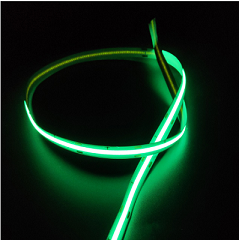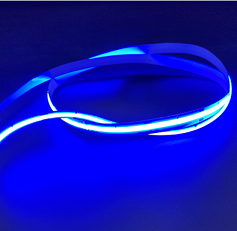The origin of “neon”
The neon lamp, born in 1898, is to inject a rare gas, neon, into a vacuum glass tube, and then connect the metal electrodes enclosed in both ends of the glass tube to a high-voltage power source, which strikes the neon in the tube under the action of a high-voltage electric field. Gas to produce a glowing effect. Therefore, this kind of lamp that energizes and emits light to the gas was later named “neon light”, transliterated as neon.
480leds/m COB LED strip red/blue/green
With the development of LED semiconductor technology, neon lights that use LEDs as light sources have gradually replaced traditional neon lights with their high light efficiency, low energy consumption, and high reliability. The material of the lamp body is also replaced by the flexible flexible plastic material from the glass material of the traditional cold cathode tube. Its application is simpler, more reliable, and has wider application fields.
The LED flexible neon strips using PVC materials were introduced to the market earlier, and rely on their mature technology and price advantages to continue to use today, but as the market puts forward higher requirements for products and applications, the defects of PVC material characteristics gradually appear. Therefore, one A kind of better performance material-silicone has entered this field. After the continuous improvement of process technology in recent years, the technology of LED silicone neon light strip has become increasingly mature and perfect, and its excellent characteristics have made it succeed the PVC neon light strip to gradually become the current market. The mainstream development direction.
Performance analysis of PVC and silicone materials
360leds/m COB LED Strips White Color
For the flexible neon strips using PVC and silicone materials on the current market, the following comparative analysis is made from the materials themselves:
The temperature resistance of PVC material is about -15℃-80℃, the material feels hard, and it is easily affected by various factors outdoors. The stability of light and heat is poor. After prolonged exposure to sunlight, it will decompose to produce hydrogen chloride, and further automatic catalytic decomposition. It causes discoloration, and the physical and mechanical properties also decrease rapidly, leading to hardening and cracking. It is not suitable for use in particularly humid places with acid, alkali and salt corrosion. In addition, the burning of PVC will produce irritating and toxic gases.
Post time: Jul-07-2020




